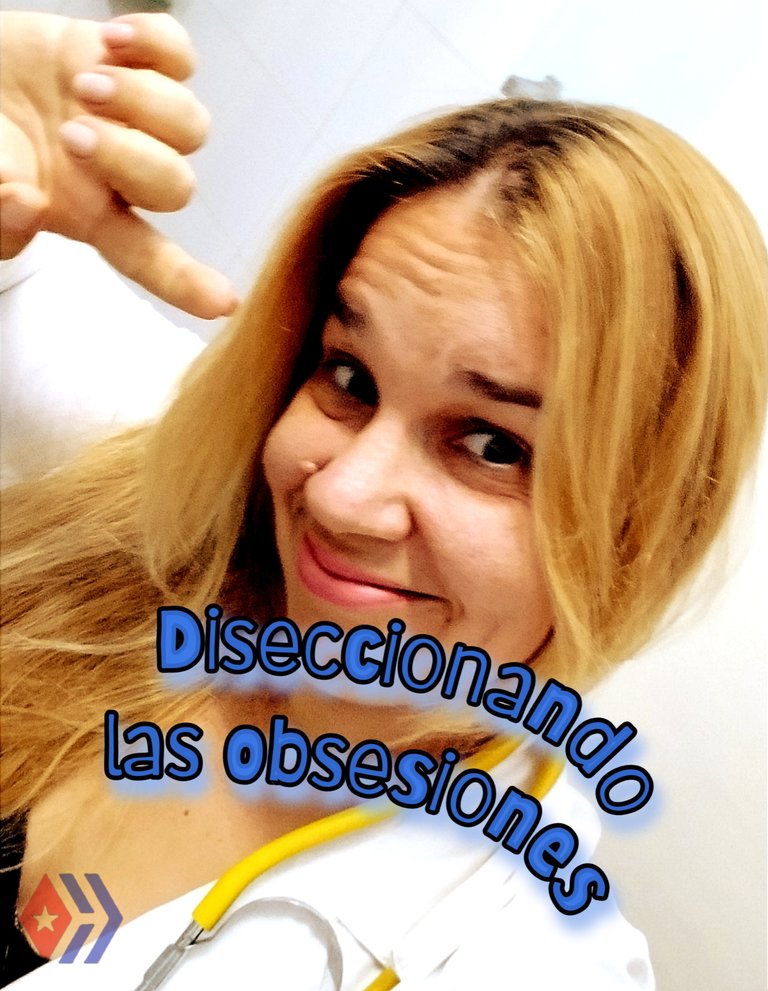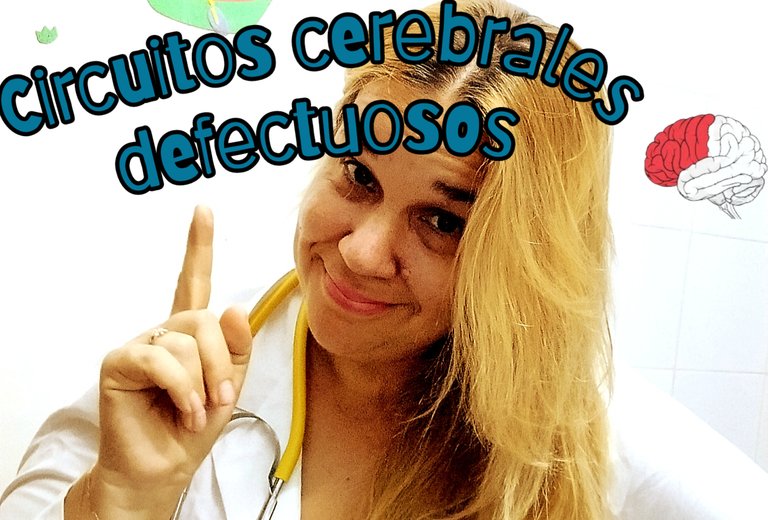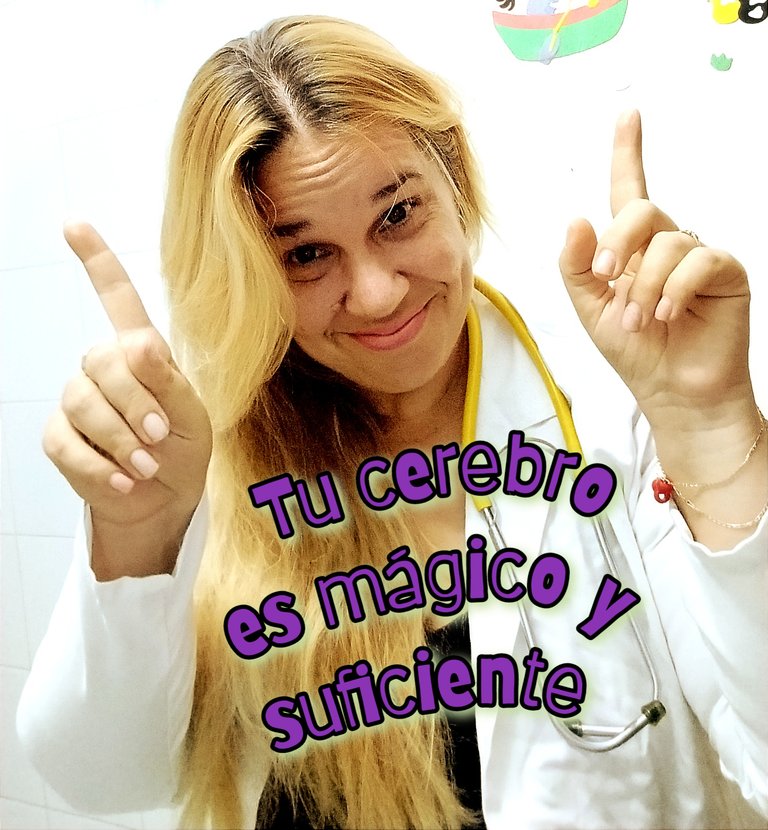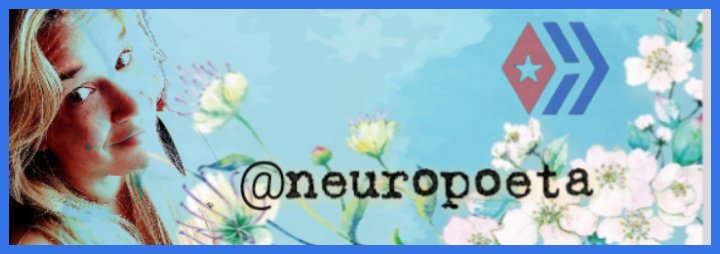Diseccionando las obsesiones - Bitácora de una Neuróloga (Esp/Eng)
Llego nuevamente a Holos&Lotus 🪷, como si llegara a mi hogar, y vengo motivada por la mágica amiga @iriswrite y su post acerca de las obsesiones. No encuentro mejor incentivo que ese para vestirme de médico y garabatear otra página de la Bitácora de una Neuróloga, algo que comencé justamente al llegar a este fascinante mundo Hive.

Creo que todos tenemos una definición muy particular de las obsesiones, pero lo cierto es que vale aclarar que son pensamientos, imágenes o impulsos no deseados que terminan provocando ansiedades que la persona no puede controlar.
Imagina tener a tu cerebro encarcelado; las obsesiones provocan un malestar parecido. Ninguna persona obsesionada está en paz, y mucho menos cerca de la felicidad y la armonía.
Se han hecho estudios neurocientíficos que muestran que las obsesiones ocurren por una disfunción en circuitos cerebrales específicos, como la corteza orbitofrontal, donde se toman las decisiones, se evalúan riesgos y se controlan impulsos. En las personas obsesionadas, esta zona es hiperactiva y hace que sobrevaloremos las amenazas, como cuando pensamos que si no nos lavamos las manos veinte veces moriremos, o que si pasamos por debajo de señales y vallas nos ocurrirá algo malo.

Otras estructuras, como los ganglios basales, actúan como filtros de pensamientos y, en las obsesiones, no filtran bien; o como el tálamo y la amígdala, que también están defectuosos. Esta última, que controla el miedo y la ansiedad, en estas personas está hiperactiva, haciendo que en situaciones neutras perciban peligros, como cuando evitamos pisar las rayas en las aceras.
Además de estos circuitos cerebrales, que yo encuentro fascinantes, el cerebro tiene mensajeros químicos: los neurotransmisores, que también juegan un papel importante cuando de obsesiones hablamos. Niveles bajos de serotonina aumentan la ansiedad y los pensamientos repetitivos, mientras que el exceso de glutamato empeora el circuito obsesivo.
Esperando no haberlos agobiado entre tantos neurotransmisores y circuitos cerebrales, les resumo un cerebro con obsesiones:
El pensamiento surge 👉🏻 la corteza orbitofrontal lo marca como urgente (aunque no lo sea) 👉🏻 el caudado no lo frena 👉🏻 el tálamo lo repite 👉🏻 la amígdala genera ansiedad 👉🏻 y así se genera un ¡bucle sin fin!

Todo esto explica por qué las personas con TOC (Trastorno Obsesivo-Compulsivo) no pueden simplemente dejar de pensar en sus obsesiones: su cerebro está atrapado en un ciclo. De ahí que volvamos a la tesis inicial: el cerebro de una persona obsesionada está dentro de una cárcel.
¡Sencillo! Imagina que tu cerebro es un sistema de alarma. En una persona sin obsesiones, la alarma suena ante peligros reales y se apaga sola; pero en una persona con obsesiones, la alarma se activa por cosas que no son peligrosas y no hay un botón de apagado.
No es falta de fuerza de voluntad: es que tu cerebro está atrapado en un bucle neurológico.

Pero ante todo esto hay una buena noticia, pues cada cerebro es mágico y suficiente por sí solo, y puede reaprender. Las obsesiones son como un camino neurológico muy transitado: cuanto más lo usas, más profundas se hacen las huellas. Pero hay técnicas para encontrar nuevas rutas y debilitarlas.
¿Te suena el truco del retraso, la técnica del grounding o el interruptor sensorial? Pues sí, son técnicas para debilitar las obsesiones, pero ya eso es material para un buen neuropsiquiatra y otro post.

✨ ¡𝑮𝒓𝒂𝒄𝒊𝒂𝒔 𝒑𝒐𝒓 𝒍𝒆𝒆𝒓! ✨
𝑺𝒊 𝒂ú𝒏 𝒏𝒐 𝒎𝒆 𝒄𝒐𝒏𝒐𝒄𝒆𝒔: 𝒔𝒐𝒚 𝒏𝒆𝒖𝒓ó𝒍𝒐𝒈𝒂 𝒚 𝒆𝒔𝒄𝒓𝒊𝒕𝒐𝒓𝒂 𝒄𝒖𝒃𝒂𝒏𝒂, 𝒎𝒂𝒅𝒓𝒆, 𝒎𝒖𝒋𝒆𝒓 𝒚 𝒔𝒐ñ𝒂𝒅𝒐𝒓𝒂 𝒒𝒖𝒆 𝒆𝒏𝒄𝒐𝒏𝒕𝒓ó 𝒆𝒏 𝑯𝒊𝒗𝒆 𝒖𝒏 𝒉𝒆𝒓𝒎𝒐𝒔𝒐 𝒆𝒔𝒑𝒂𝒄𝒊𝒐 𝒑𝒂𝒓𝒂 𝒗𝒐𝒍𝒂𝒓.
𝑬𝒍 𝒕𝒆𝒙𝒕𝒐 𝒚 𝒍𝒂𝒔 𝒊𝒎á𝒈𝒆𝒏𝒆𝒔 𝒔𝒐𝒏 𝒅𝒆 𝒎𝒊 𝒂𝒖𝒕𝒐𝒓í𝒂, 100% 𝒉𝒖𝒎𝒂𝒏𝒐𝒔 (𝒔𝒊𝒏 𝑰𝑨).
𝑩𝒂𝒏𝒏𝒆𝒓 𝒅𝒊𝒔𝒆ñ𝒂𝒅𝒐 𝒑𝒐𝒓 𝑳𝒖𝒎𝒊𝒊.
¿𝑻𝒆 𝒈𝒖𝒔𝒕ó 𝒆𝒔𝒕𝒂 𝒑𝒖𝒃𝒍𝒊𝒄𝒂𝒄𝒊ó𝒏? 𝑽𝒐𝒕𝒂, 𝒄𝒐𝒎𝒆𝒏𝒕𝒂 𝒐 𝒓𝒆𝒃𝒍𝒐𝒈𝒖𝒆𝒂 𝒑𝒂𝒓𝒂 𝒂𝒚𝒖𝒅𝒂𝒓 𝒂 𝒅𝒆𝒔𝒑𝒍𝒆𝒈𝒂𝒓 𝒆𝒔𝒕𝒂𝒔 𝒂𝒍𝒂𝒔. 💛
ENGLISH
Dissected Obsessions - A Neurologist's Log
I return once again to Holos&Lotus 🪷 as if coming home, inspired by my magical friend @iriswrite and her post about obsessions. I can’t think of a better incentive to put on my doctor’s coat and scribble another page of A Neurologist’s Logbook, something I started precisely when I entered this fascinating Hive world.

I believe we all have our own unique definition of obsessions, but the truth is, it’s important to clarify that they are unwanted thoughts, images, or impulses that end up causing uncontrollable anxiety.
Imagine your brain being imprisoned—obsessions cause a similar distress. No obsessed person is at peace, let alone close to happiness and harmony.
Neuroscientific studies suggest that obsessions arise from dysfunction in specific brain circuits, such as the orbitofrontal cortex, where decisions are made, risks are assessed, and impulses are controlled. In people with obsessions, this area is hyperactive, making them overestimate threats—like thinking they’ll die if they don’t wash their hands twenty times or that something bad will happen if they walk under signs and fences.

Other structures, like the basal ganglia, act as thought filters and don’t work properly in obsessions. The thalamus and amygdala are also impaired—the latter, which controls fear and anxiety, becomes hyperactive in these individuals, making them perceive danger in neutral situations, like avoiding stepping on sidewalk cracks.
Beyond these fascinating brain circuits, the brain has chemical messengers: neurotransmitters, which also play a key role in obsessions. Low serotonin levels increase anxiety and repetitive thoughts, while excess glutamate worsens the obsessive loop.
Hoping I haven’t overwhelmed you with all these neurotransmitters and brain circuits, here’s a summary of an obsessed brain:
A thought arises 👉🏻 the orbitofrontal cortex flags it as urgent (even if it’s not) 👉🏻 the caudate doesn’t stop it 👉🏻 the thalamus repeats it 👉🏻 the amygdala generates anxiety 👉🏻 and thus, an endless loop is created!

This explains why people with OCD (Obsessive-Compulsive Disorder) can’t just stop thinking about their obsessions—their brain is stuck in a cycle. Hence, we return to the initial thesis: an obsessed person’s brain is trapped in a prison.
Simple! Imagine your brain is an alarm system. In a person without obsessions, the alarm goes off for real dangers and turns off by itself. But in someone with obsessions, the alarm triggers over non-threatening things, and there’s no off button.
It’s not a lack of willpower—it’s your brain stuck in a neurological loop.

But there’s good news: every brain is magical and self-sufficient, capable of relearning. Obsessions are like a well-trodden neural path—the more you use it, the deeper the tracks become. But there are techniques to forge new routes and weaken them.
Ever heard of the delay trick, grounding technique, or sensory switch? Yes, these are methods to weaken obsessions—but that’s material for a skilled neuropsychiatrist and another post.

✨ 𝑻𝒉𝒂𝒏𝒌𝒔 𝒇𝒐𝒓 𝒓𝒆𝒂𝒅𝒊𝒏𝒈! ✨
𝑰𝒇 𝒚𝒐𝒖 𝒅𝒐𝒏’𝒕 𝒌𝒏𝒐𝒘 𝒎𝒆 𝒚𝒆𝒕—𝑰’𝒎 𝒂 𝑪𝒖𝒃𝒂𝒏 𝒏𝒆𝒖𝒓𝒐𝒍𝒐𝒈𝒊𝒔𝒕 𝒂𝒏𝒅 𝒘𝒓𝒊𝒕𝒆𝒓, 𝒂 𝒎𝒐𝒕𝒉𝒆𝒓, 𝒂 𝒘𝒐𝒎𝒂𝒏, 𝒂𝒏𝒅 𝒂 𝒅𝒓𝒆𝒂𝒎𝒆𝒓 𝒘𝒉𝒐’𝒔 𝒇𝒐𝒖𝒏𝒅 𝒊𝒏 𝑯𝒊𝒗𝒆 𝒂 𝒃𝒆𝒂𝒖𝒕𝒊𝒇𝒖𝒍 𝒔𝒑𝒂𝒄𝒆 𝒕𝒐 𝒔𝒐𝒂𝒓.
𝑨𝒍𝒍 𝒕𝒆𝒙𝒕 𝒂𝒏𝒅 𝒊𝒎𝒂𝒈𝒆𝒔 𝒂𝒓𝒆 𝒎𝒚 𝒐𝒓𝒊𝒈𝒊𝒏𝒂𝒍 𝒄𝒓𝒆𝒂𝒕𝒊𝒐𝒏𝒔, 100% 𝒉𝒖𝒎𝒂𝒏-𝒎𝒂𝒅𝒆 (𝒏𝒐 𝑨𝑰).
𝑩𝒂𝒏𝒏𝒆𝒓 𝒅𝒆𝒔𝒊𝒈𝒏𝒆𝒅 𝒃𝒚 𝑳𝒖𝒎𝒊𝒊.
𝑳𝒐𝒗𝒆𝒅 𝒕𝒉𝒊𝒔 𝒑𝒐𝒔𝒕? 𝑼𝒑𝒗𝒐𝒕𝒆, 𝒄𝒐𝒎𝒎𝒆𝒏𝒕, 𝒐𝒓 𝒓𝒆𝒃𝒍𝒐𝒈 𝒕𝒐 𝒔𝒑𝒓𝒆𝒂𝒅 𝒕𝒉𝒆 𝒘𝒊𝒏𝒈𝒔 𝒐𝒇 𝒄𝒓𝒆𝒂𝒕𝒊𝒗𝒊𝒕𝒚! 💛
Super interesante, que bueno es saber que por lo menos son problemas qué no determina el ser humano. Y lo mejor es saber que no estamos dominados del todo jjj. Gracias por tan explícito abordaje. Un abrazo
Gracias por darme el pie a la reflexión 😉🌻🫂
De lujo, necesitábamos una neurología como tú para entender muchas cosas. Tu contenido está siendo muy provechoso en esta casa.
Ahora sé por qué estoy obsesionada con las notificaciones de mi WhatsApp. Tendré que hacer que mi cerebro no identifique mi buzón de mensajes como un peligro🤭
Pero es que a veces sí es un peligro ⚡... Yo le temo al sonido de mi móvil a ciertas horas y no es obsesión, es peligro real 🤭🤭
You received an upvote ecency
¡Felicitaciones!
Estás participando para optar a la mención especial que se efectuará el domingo 22 de junio del 2025 a las 8:00 pm (hora de Venezuela), gracias a la cual el autor del artículo seleccionado recibirá la cantidad de 1 HIVE transferida a su cuenta.
¡También has recibido 1 ENTROKEN! El token del PROYECTO ENTROPÍA impulsado por la plataforma Steem-Engine.
1. Invierte en el PROYECTO ENTROPÍA y recibe ganancias semanalmente. Entra aquí para más información.
2. Contáctanos en Discord: https://discord.gg/hkCjFeb
3. Suscríbete a nuestra COMUNIDAD y apoya al trail de @Entropia y así podrás ganar recompensas de curación de forma automática. Entra aquí para más información sobre nuestro trail.
4. Visita nuestro canal de Youtube.
Atentamente
El equipo de curación del PROYECTO ENTROPÍA
Gracias por el apoyo ✨🌻🙏🏻